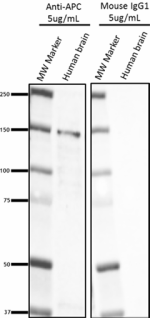- Clone
- Ali 12-28 (See other available formats)
- Regulatory Status
- RUO
- Other Names
- APC, BTPS2, DP2, DP2.5, DP3, PPP1R46, WNT signaling pathway regulator, adenomatosis polyposis coli tumor suppressor, deleted in polyposis 2.5, protein phosphatase 1, regulatory subunit 46, truncated adenomatosis polyposis coli
- Isotype
- Mouse IgG1, κ
- Ave. Rating
- Submit a Review
- Product Citations
- publications

-

Western blot of anti-Adenomatous polyposis coli protein (APC) antibody (clone Ali 12-28) and isotype-matched IgG1 control. Blots were incubated with 5µg/ml of anti-APC (left) or mouse IgG1 isotype control (right) overnight at 4°C, followed by the incubation with an HRP goat anti-mouse IgG secondary antibody (clone Poly4053). Enhanced chemiluminescence was used as the detection system. MW: molecular weight marker; human brain lysates: 20µg.
| Cat # | Size | Price | Quantity Check Availability | Save | ||
|---|---|---|---|---|---|---|
| 850801 | 25 µg | $141 | ||||
| 850802 | 100 µg | $352 | ||||
The APC gene provides instructions for making the APC protein, which plays a critical role in several cellular processes. The APC protein acts as a tumor suppressor, which means that it keeps cells from growing and dividing too fast or in an uncontrolled way. It helps control how often a cell divides, how it attaches to other cells within a tissue, and whether a cell moves within or away from a tissue. This protein also helps ensure that the number of chromosomes in a cell is correct following cell division. The APC protein accomplishes these tasks mainly through association with other proteins, especially those that are involved in cell attachment and signaling.
One protein with which APC associates is beta-catenin. Beta-catenin helps control the activity (expression) of particular genes and promotes the growth and division (proliferation) of cells and the process by which cells mature to carry out specific functions (differentiation). Beta-catenin also helps cells attach to one another and is important for tissue formation. Association of APC with beta-catenin signals for beta-catenin to be broken down when it is no longer needed.
Product Details
- Verified Reactivity
- Human
- Antibody Type
- Monoclonal
- Host Species
- Mouse
- Immunogen
- N-terminal APC-MBP fusion protein
- Formulation
- Phosphate-buffered solution, pH 7.2, containing 0.09% sodium azide.
- Preparation
- The antibody was purified by affinity chromatography.
- Concentration
- 0.5 mg/mL
- Storage & Handling
- The antibody solution should be stored undiluted between 2°C and 8°C.
- Application
-
WB - Quality tested
ICC - Reported in the literature, not verified in house - Recommended Usage
-
Each lot of this antibody is quality control tested by Western blotting. For Western blotting, the suggested use of this reagent is 1.0 - 5.0 µg per mL. It is recommended that the reagent be titrated for optimal performance for each application.
- Application Notes
-
Additional reported applications (for the relevant formats) include: immunofluorescence microscopy1.
-
Application References
(PubMed link indicates BioLegend citation) -
- Boehlke C, et al. 2013. PLoS One. 8(5):e62165. (IF)
- Hadjihannas MV, et al. 2012. EMBO Rep. 13(4):347-54. (WB)
- Tanneberger K, et al. 2011. J. Biol. Chem. 286(22):19204-14. (WB)
- RRID
-
AB_2716017 (BioLegend Cat. No. 850801)
AB_2716018 (BioLegend Cat. No. 850802)
Antigen Details
- Structure
- APC is a 2843 amino acid protein with a molecular weight of 311 kD.
- Distribution
-
Tissue distribution: expressed in wide variety of normal tissues.
Cellular distribution: cellular junctions, cytoplasm and membranous expression. - Function
- APC is a tumor suppressor involved in Wnt signaling. It is also involved in additional processes including cell migration and adhesion, transcriptional activation and apoptosis.
- Biology Area
- Cell Biology, Neuroscience, Neuroscience Cell Markers
- Molecular Family
- Tumor Suppressors
- Antigen References
-
1. Barth AI, et al. 2008. Semin. Cell. Dev. Biol. 19(3):245-51.
- Gene ID
- 324 View all products for this Gene ID
- UniProt
- View information about Adenomatous polyposis coli on UniProt.org
Related Pages & Pathways
Pages
Related FAQs
Other Formats
View All Adenomatous polyposis coli Reagents Request Custom Conjugation| Description | Clone | Applications |
|---|---|---|
| Purified anti-Adenomatous polyposis coli (APC) | Ali 12-28 | WB,ICC |
Compare Data Across All Formats
This data display is provided for general comparisons between formats.
Your actual data may vary due to variations in samples, target cells, instruments and their settings, staining conditions, and other factors.
If you need assistance with selecting the best format contact our expert technical support team.
-
Purified anti-Adenomatous polyposis coli (APC)

Western blot of anti-Adenomatous polyposis coli protein (APC...
 Login/Register
Login/Register 







Follow Us